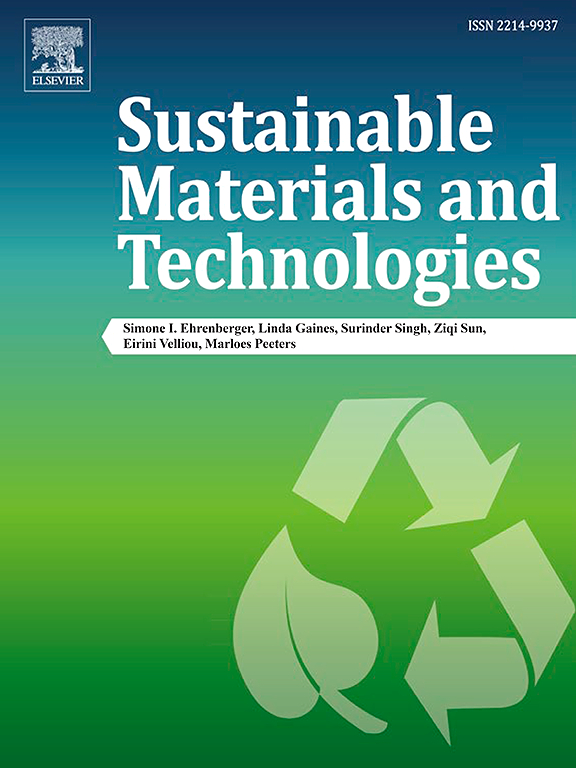低排放新一代不锈钢E304-16和E316-16低碳钢芯线合成电极的研制
IF 8.6
2区 工程技术
Q1 ENERGY & FUELS
引用次数: 0
摘要
由于对具有最小有害排放的高性能材料的需求,对具有成本效益和环境可持续性的焊接电极的需求显着增加。本研究的重点是开发一种新型的不锈钢焊条,该焊条采用了助焊剂改性的低碳钢芯线。主要目标是实现类似不锈钢的机械性能,同时最大限度地减少六价铬、臭氧和紫外线辐射等有害排放物的释放。这些新开发的电极旨在提供304和316不锈钢等级的强度和耐腐蚀性,而无需修改传统的制造工艺,使其非常适合工业应用,包括结构制造,汽车部件和海洋工程。采用纳米碳酸钙和钛酸钙配制了一种新型助熔剂,提高了电弧稳定性,减少了飞溅,提高了合金化效率。力学测试表明,拉伸性能有显著改善,304不锈钢电极的极限拉伸强度增加到544 MPa, 316不锈钢电极的极限拉伸强度增加到560 MPa。屈服抗拉强度分别提高到230 MPa和285 MPa,抗变形能力增强。不锈钢304电极的抗弯强度提高到460 MPa左右,不锈钢316电极的抗弯强度提高到490 MPa左右,显微硬度分别提高到240维氏硬度数(VHN)和250维氏硬度数(VHN)。显微组织分析表明,焊缝组织细化,针状铁素体含量增加,焊缝完整性和强度提高。此外,优化后的助焊剂配方有效地减少了有毒排放物的释放,304不锈钢电极的六价铬浓度降低了32.7%,316不锈钢电极的六价铬浓度降低了22.7%。这些结果表明,新开发的电极提供了机械性能和环境可持续性的平衡组合。这种新方法不仅提高了不锈钢焊接的效率,而且大大降低了焊工的健康风险。这一发现有助于清洁焊接技术的发展,为各种工业应用提供了一种具有成本效益和可持续性的替代方案。本文章由计算机程序翻译,如有差异,请以英文原文为准。
Development of low-emission next-generation stainless steel E304–16 and E316–16 synthetic electrodes with mild steel Core wire
The demand for cost-effective and environmentally sustainable welding electrodes has increased significantly due to the need for high-performance materials with minimal hazardous emissions. This study focuses on developing novel stainless steel welding electrodes using a flux-modified mild steel core wire. The primary objective is to achieve stainless steel-like mechanical properties while minimizing the release of hazardous emissions such as hexavalent chromium, ozone, and ultraviolet radiation. These newly developed electrodes are designed to provide the strength and corrosion resistance of stainless steel grades 304 and 316 without requiring modifications to conventional manufacturing processes, making them highly suitable for industrial applications, including structural fabrication, automotive components, and marine engineering. A novel flux composition incorporating nano-sized calcium carbonate and calcium titanate was formulated to enhance arc stability, reduce spatter, and improve alloying efficiency. Mechanical testing demonstrated significant improvements in tensile properties, with the ultimate tensile strength increasing to 544 MPa for the stainless steel 304 electrode and 560 MPa for the stainless steel 316 electrode. The yield tensile strength increased to 230 MPa and 285 MPa, respectively, reflecting enhanced resistance to deformation. Bending strength improved to approximately 460 MPa for the stainless steel 304 electrode and 490 MPa for the stainless steel 316 electrode, while microhardness values increased to 240 Vickers hardness number (VHN) and 250 VHN, respectively. Microstructural analysis revealed a refined weld structure with increased acicular ferrite content, leading to enhanced weld integrity and strength. In addition, the optimized flux formulation effectively reduced the release of toxic emissions, with hexavalent chromium concentrations decreasing by 32.7 % for stainless steel 304 electrodes and 22.7 % for stainless steel 316 electrodes. These results demonstrate that the newly developed electrodes provide a balanced combination of mechanical performance and environmental sustainability. The novel approach not only enhances the efficiency of stainless steel welding but also significantly reduces health risks for welders. The findings contribute to the advancement of cleaner welding technologies, offering a cost-effective and sustainable alternative for various industrial applications.
求助全文
通过发布文献求助,成功后即可免费获取论文全文。
去求助
来源期刊

Sustainable Materials and Technologies
Energy-Renewable Energy, Sustainability and the Environment
CiteScore
13.40
自引率
4.20%
发文量
158
审稿时长
45 days
期刊介绍:
Sustainable Materials and Technologies (SM&T), an international, cross-disciplinary, fully open access journal published by Elsevier, focuses on original full-length research articles and reviews. It covers applied or fundamental science of nano-, micro-, meso-, and macro-scale aspects of materials and technologies for sustainable development. SM&T gives special attention to contributions that bridge the knowledge gap between materials and system designs.
 求助内容:
求助内容: 应助结果提醒方式:
应助结果提醒方式:


